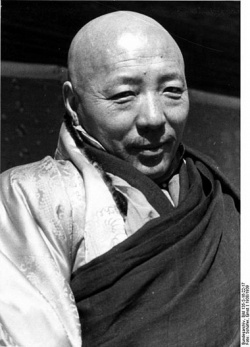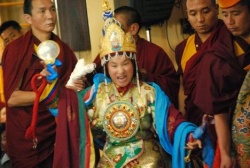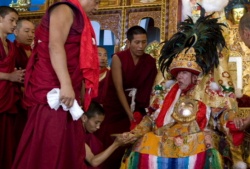Difference between revisions of "Nechung Oracle"
(Created page with "thumb|250px| <poem> The Nechung Oracle is the State Oracle of Tibet. The medium of the State Oracle currently resides with the current Dalai Lama in ...") |
|||
| (4 intermediate revisions by 2 users not shown) | |||
| Line 1: | Line 1: | ||
[[File:Staatsorakel.jpg|thumb|250px|]] | [[File:Staatsorakel.jpg|thumb|250px|]] | ||
| + | |||
| + | |||
| + | |||
| + | |||
| + | |||
| + | |||
<poem> | <poem> | ||
| − | The Nechung Oracle is the State Oracle of Tibet. The medium of the State Oracle currently resides with the current Dalai Lama in Dharamsala, India. Prior to the Himalayan diaspora resulting from the annexation of Tibet by the Chinese Cultural Revolution,[ | + | The [[Nechung Oracle]] is the [[State Oracle of Tibet]]. |
| + | |||
| + | The [[medium of the State Oracle]] currently resides with the current [[Dalai Lama]] in [[Dharamsala]], [[India]]. | ||
| + | |||
| + | Prior to the [[Himalayan]] {{Wiki|diaspora}} resulting from the annexation of [[Tibet]] by the [[Chinese Cultural Revolution]], the [[Nechung]] {{Wiki|Oracle}} was the designated head of the [[Nechung]] [[monastery]] [[in Tibet]]. | ||
History | History | ||
| − | In Tibet and throughout the greater Himalayan region, oracles have, and continue to play, an important part in revelation, religion, | + | In [[Tibet]] and throughout the greater [[Himalayan]] region, {{Wiki|oracles}} have, and continue to play, an important part in [[revelation]], [[religion]], [[Doctrine]], and {{Wiki|prophecy}}. In [[Tibet]], the [[Nechung]] {{Wiki|Oracle}} and other {{Wiki|oracles}} on occasion, have also played [[principal]] roles assisting governmental decision-making and providing [[intelligence]] on pressing matters of [[state]], and perhaps most importantly aid in the provision of {{Wiki|security}} for the [[14th Dalai Lama]] of [[Tibet]]. |
| − | There are a number of oracular traditions within the Himalaya of which the Nechung is but one. The word "oracle" is used by Tibetans to refer to the spirit, deity, or entity that temporarily (or various styles of periodic or ongoing possession depending on the tradition) possesses enters those men and women who act as media between the phenomenal natural world and the subtle spiritual realms. These media are, therefore, known as kuten, which literally means, "the physical basis". Post-possession the medium may require protracted convalescence. | + | There are a number of {{Wiki|oracular}} [[traditions]] within the [[Himalaya]] of which the [[Nechung]] is but one. The [[word]] "{{Wiki|oracle}}" is used by [[Tibetans]] to refer to the [[spirit]], [[deity]], or [[entity]] that temporarily (or various styles of periodic or ongoing possession depending on the [[tradition]]) possesses enters those men and women who act as media between the [[phenomenal]] natural [[world]] and the {{Wiki|subtle}} [[spiritual realms]]. These media are, therefore, known as [[kuten]], which literally means, "the [[physical]] basis". Post-possession the {{Wiki|medium}} may require protracted convalescence. |
[[File:Oracle.jpg|thumb|250px|]] | [[File:Oracle.jpg|thumb|250px|]] | ||
| − | The | + | The [[Tulku]] of the institution of the [[Dalai Lama]], consults the {{Wiki|oracle}} known as the [[Nechung]] {{Wiki|Oracle}}, which is considered the Official [[State Oracle]] of the government of [[Tibet]]. The [[Nechung]] was formerly a [[Nyingma]] [[tradition]]. He gives a complete description of the process of [[trance]] and possession in his [[book]] Freedom in Exile. |
Beginnings | Beginnings | ||
| − | Pearlman (2002: p. 94) frames the inauguration and installation of the tradition of the State Oracle by identifying key stakeholders: Padmasambhava, Samye, Vajrakilaya, Dharma, | + | Pearlman (2002: p. 94) frames the inauguration and installation of the [[tradition]] of the [[State Oracle]] by identifying key stakeholders: [[Padmasambhava]], [[Samye]], [[Vajrakilaya]], [[Dharma]], [[Sangha]], genius loci: |
| − | "When Padmasambhava consecrated Samye Monastery with the Vajrakilaya dance, he tamed the local spirit protector, Pehar Gyalp, and bound him by oath to become the head of the entire hierarchy of Buddhist protective spirits. Pehar, later known as Dorje Drakden, became the principal protector of the Dalai Lamas, manifesting through the Nechung Oracle. | + | "When [[Padmasambhava]] [[consecrated]] [[Samye Monastery]] with the [[Vajrakilaya dance]], he tamed the local [[spirit]] [[protector]], [[Pehar]] Gyalp, and [[bound]] him by oath to become the head of the entire {{Wiki|hierarchy}} of [[Buddhist]] [[protective spirits]]. [[Pehar]], later known as [[Dorje Drakden]], became the [[principal]] [[protector]] of the [[Dalai]] [[Lamas]], [[manifesting]] through the [[Nechung]] {{Wiki|Oracle}}. |
| − | According to the Dalai Lama, "Tibetans rely on oracles for various reasons. The purpose of the oracles is not just to foretell the future. They are called upon as | + | According to the [[Dalai Lama]], "[[Tibetans]] rely on {{Wiki|oracles}} for various [[reasons]]. The {{Wiki|purpose}} of the {{Wiki|oracles}} is not just to foretell the {{Wiki|future}}. They are called upon as [[Protectors]] and sometimes used as healers. However, their primary function is to {{Wiki|protect}} The [[Buddha]] [[Dharma]] and its practitioners." |
| − | The rite of the Oracle possessing the kuten is ancient, entering the tradition from the Bonpo and Ngagpa, and traditionally involves a detailed evocative liturgy including such elements as fanfare, dance, mudra and | + | The [[rite]] of the {{Wiki|Oracle}} possessing the [[kuten]] is [[ancient]], entering the [[tradition]] from the [[Bonpo]] and [[Ngagpa]], and [[traditionally]] involves a detailed evocative liturgy [[including]] such [[elements]] as fanfare, [[dance]], [[mudra]] and [[Mantra]] to invoke the {{Wiki|Oracle}} who forcefully projects their [[Mindstream]] via the [[discipline]] of [[phowa]], temporarily possessing the [[physical]] basis. |
| − | Key prophecies | + | Key {{Wiki|prophecies}} |
[[File:Oracle_3.jpg|thumb|250px|]] | [[File:Oracle_3.jpg|thumb|250px|]] | ||
| − | Pearlman (2002: p. 94) relates two prophecies prophesied by the Nechung Oracle: the famous prophecy that during the Year of the Tiger Tibet would encounter a grave and "great difficulty"; and the fortuitous second prophecy outlining the flight from Tibet of the Jewel of the Compassionate Ocean, an epiphet for the Dalai Lama: | + | Pearlman (2002: p. 94) relates two {{Wiki|prophecies}} prophesied by the [[Nechung]] {{Wiki|Oracle}}: the famous {{Wiki|prophecy}} that during the Year of the [[Tiger]] [[Tibet]] would encounter a grave and "great difficulty"; and the fortuitous second {{Wiki|prophecy}} outlining the flight from [[Tibet]] of the [[Jewel]] of the [[Compassionate]] Ocean, an epiphet for the [[Dalai Lama]]: |
| + | |||
| + | "In 1947 [[Lobsang Jigme]], the [[Tibetan State Oracle]], prophesied that in the Year of the [[Tiger]], 1950, [[Tibet]] would face great difficulty. In 1951, [[Lobsang Jigme]] fell ill, some say because of his repeated troubling [[visions]], and for years was unable to walk without assistance. In 1959, after predicting the [[Dalai Lama]]'s flight, [[Lobsang Jigme]] spent two months walking to [[India]] with [[His Holiness]]. His {{Wiki|illness}} was eventually cured." | ||
| + | |||
| + | {{Wiki|Ceremony}} | ||
| − | + | Pearlman (2002: p. 94-95) describes the [[ritual]] investiture of the [[Nechung]] {{Wiki|Oracle}} that is constituted by [[sacred]] [[symbols]] and [[iconography]] in the colours of the [[Five Pure Lights]] and [[Mahabhuta]] and includes [[lungta]], [[Bija]] and [[dhvaja]]: | |
| − | + | "On formal occasions, the [[Kuten]] is dressed in an elaborate costume consisting of several layers of clothing topped by a highly ornate robe of golden {{Wiki|silk}} brocade, which is covered with [[ancient]] designs in [[red]] and blue and [[green]] and [[yellow]] [colors [[traditionally]] subscribed to the [[Mahabhuta]]]. On his {{Wiki|chest}} he wears a circular [[mirror]] which is surrounded by [[clusters]] of {{Wiki|turquoise}} and amethyst, its polished steel flashing with the [[Sanskrit]] [[Mantra]] [[corresponding]] to [[Dorje Drakden]]. Before the proceedings begin, he also puts on a sort of harness, which supports four flags and three [[victory banners]]. Altogether, this outfit weighs more than seventy pounds and the {{Wiki|medium}}, when not in [[trance]], can hardly walk in it." | |
| − | Pearlman | + | In addition to this regalia, when the Kuten's [[trance]] deepens, the assistants that have been supporting the {{Wiki|medium}} place a headress on his head which weighs approximately 30 pounds, though in former times it weighed over 80. (Pearlman, 2002: p. 96) The circular [[mirror]] is a [[divine]] attribute and tool, known as a [[melong]] ([[Tibetan]]: "[[mirror]]"), that is a potent polyvalent [[Symbol]] of [[Dzogchen]] and [[Dzogchen]] teachings. |
| + | [[Nechung]] {{Wiki|Oracle}} ([[Wyl.]] [[gnas chung sku rten]]) is the [[state oracle of Tibet]], who communicates with the [[deity]] [[Pehar]], usually indirectly, via the lesser [[deities]] [[Dorje Drakden]] and [[Shingjachen]]. | ||
| + | Past & Present {{Wiki|Oracles}} | ||
| − | + | The previous {{Wiki|oracle}}, [[Lobsang Jigme]] (1930-1984) was the twelfth [[state oracle]]. | |
| − | + | The {{Wiki|present}} {{Wiki|oracle}}, Ven. [[Thupten Ngodup]] was born [[in Tibet]] in 1958 and is a descendant of the famous [[master]], [[Nyang Ral Nyima Özer]] (1136-1204). Following the [[Wikipedia:Battle of Chamdo|Chinese invasion]], he fled with his [[parents]] into exile to [[India]] and later joined the [[Nechung]] [[Monastery]] as a {{Wiki|novice}} [[Monk]] in 1971. In 1987, he was [[recognized]] as the true successor of the previous [[Nechung]] {{Wiki|Oracle}}, [[Lobsang Jigme]], who passed away in 1984, and was officially [[enthroned]] in 1988. | |
</poem> | </poem> | ||
{{W}} | {{W}} | ||
[[Category:Buddhist Terms]] | [[Category:Buddhist Terms]] | ||
[[Category:Nechung]] | [[Category:Nechung]] | ||
Latest revision as of 14:42, 6 April 2016
The Nechung Oracle is the State Oracle of Tibet.
The medium of the State Oracle currently resides with the current Dalai Lama in Dharamsala, India.
Prior to the Himalayan diaspora resulting from the annexation of Tibet by the Chinese Cultural Revolution, the Nechung Oracle was the designated head of the Nechung monastery in Tibet.
History
In Tibet and throughout the greater Himalayan region, oracles have, and continue to play, an important part in revelation, religion, Doctrine, and prophecy. In Tibet, the Nechung Oracle and other oracles on occasion, have also played principal roles assisting governmental decision-making and providing intelligence on pressing matters of state, and perhaps most importantly aid in the provision of security for the 14th Dalai Lama of Tibet.
There are a number of oracular traditions within the Himalaya of which the Nechung is but one. The word "oracle" is used by Tibetans to refer to the spirit, deity, or entity that temporarily (or various styles of periodic or ongoing possession depending on the tradition) possesses enters those men and women who act as media between the phenomenal natural world and the subtle spiritual realms. These media are, therefore, known as kuten, which literally means, "the physical basis". Post-possession the medium may require protracted convalescence.
The Tulku of the institution of the Dalai Lama, consults the oracle known as the Nechung Oracle, which is considered the Official State Oracle of the government of Tibet. The Nechung was formerly a Nyingma tradition. He gives a complete description of the process of trance and possession in his book Freedom in Exile.
Beginnings
Pearlman (2002: p. 94) frames the inauguration and installation of the tradition of the State Oracle by identifying key stakeholders: Padmasambhava, Samye, Vajrakilaya, Dharma, Sangha, genius loci:
"When Padmasambhava consecrated Samye Monastery with the Vajrakilaya dance, he tamed the local spirit protector, Pehar Gyalp, and bound him by oath to become the head of the entire hierarchy of Buddhist protective spirits. Pehar, later known as Dorje Drakden, became the principal protector of the Dalai Lamas, manifesting through the Nechung Oracle.
According to the Dalai Lama, "Tibetans rely on oracles for various reasons. The purpose of the oracles is not just to foretell the future. They are called upon as Protectors and sometimes used as healers. However, their primary function is to protect The Buddha Dharma and its practitioners."
The rite of the Oracle possessing the kuten is ancient, entering the tradition from the Bonpo and Ngagpa, and traditionally involves a detailed evocative liturgy including such elements as fanfare, dance, mudra and Mantra to invoke the Oracle who forcefully projects their Mindstream via the discipline of phowa, temporarily possessing the physical basis.
Key prophecies
Pearlman (2002: p. 94) relates two prophecies prophesied by the Nechung Oracle: the famous prophecy that during the Year of the Tiger Tibet would encounter a grave and "great difficulty"; and the fortuitous second prophecy outlining the flight from Tibet of the Jewel of the Compassionate Ocean, an epiphet for the Dalai Lama:
"In 1947 Lobsang Jigme, the Tibetan State Oracle, prophesied that in the Year of the Tiger, 1950, Tibet would face great difficulty. In 1951, Lobsang Jigme fell ill, some say because of his repeated troubling visions, and for years was unable to walk without assistance. In 1959, after predicting the Dalai Lama's flight, Lobsang Jigme spent two months walking to India with His Holiness. His illness was eventually cured."
Ceremony
Pearlman (2002: p. 94-95) describes the ritual investiture of the Nechung Oracle that is constituted by sacred symbols and iconography in the colours of the Five Pure Lights and Mahabhuta and includes lungta, Bija and dhvaja:
"On formal occasions, the Kuten is dressed in an elaborate costume consisting of several layers of clothing topped by a highly ornate robe of golden silk brocade, which is covered with ancient designs in red and blue and green and yellow [colors traditionally subscribed to the Mahabhuta]. On his chest he wears a circular mirror which is surrounded by clusters of turquoise and amethyst, its polished steel flashing with the Sanskrit Mantra corresponding to Dorje Drakden. Before the proceedings begin, he also puts on a sort of harness, which supports four flags and three victory banners. Altogether, this outfit weighs more than seventy pounds and the medium, when not in trance, can hardly walk in it."
In addition to this regalia, when the Kuten's trance deepens, the assistants that have been supporting the medium place a headress on his head which weighs approximately 30 pounds, though in former times it weighed over 80. (Pearlman, 2002: p. 96) The circular mirror is a divine attribute and tool, known as a melong (Tibetan: "mirror"), that is a potent polyvalent Symbol of Dzogchen and Dzogchen teachings.
Nechung Oracle (Wyl. gnas chung sku rten) is the state oracle of Tibet, who communicates with the deity Pehar, usually indirectly, via the lesser deities Dorje Drakden and Shingjachen.
Past & Present Oracles
The previous oracle, Lobsang Jigme (1930-1984) was the twelfth state oracle.
The present oracle, Ven. Thupten Ngodup was born in Tibet in 1958 and is a descendant of the famous master, Nyang Ral Nyima Özer (1136-1204). Following the Chinese invasion, he fled with his parents into exile to India and later joined the Nechung Monastery as a novice Monk in 1971. In 1987, he was recognized as the true successor of the previous Nechung Oracle, Lobsang Jigme, who passed away in 1984, and was officially enthroned in 1988.


